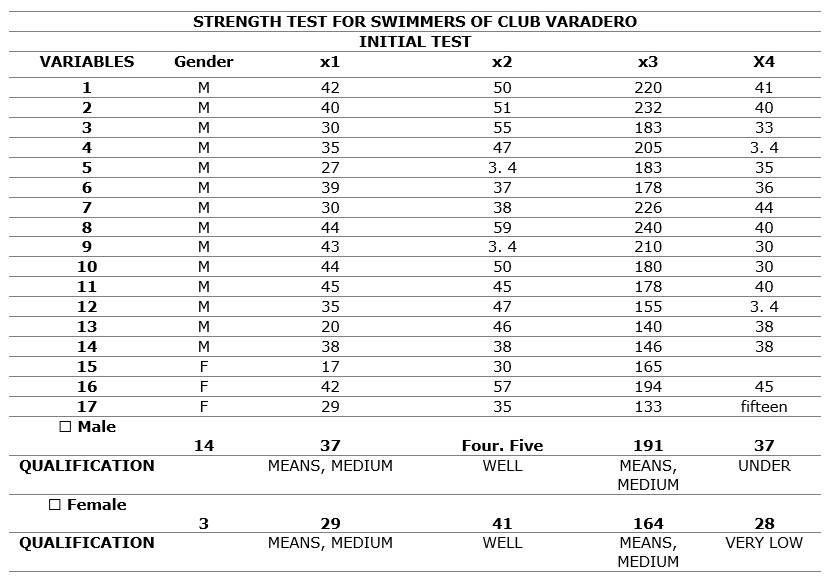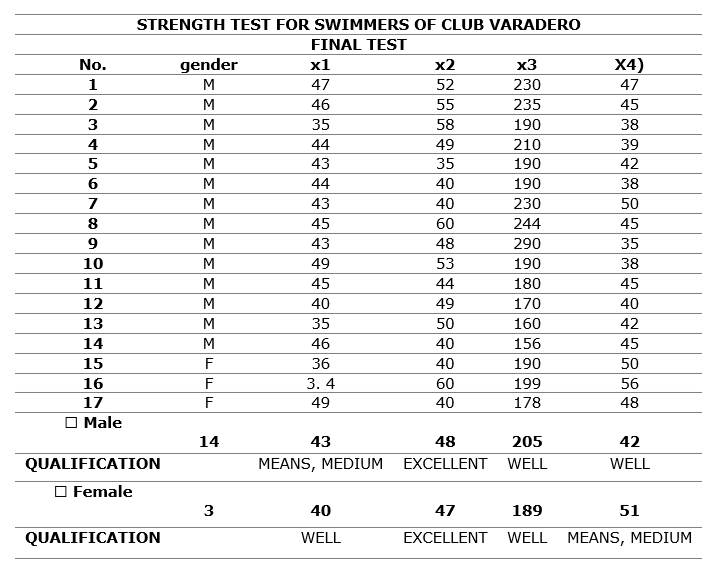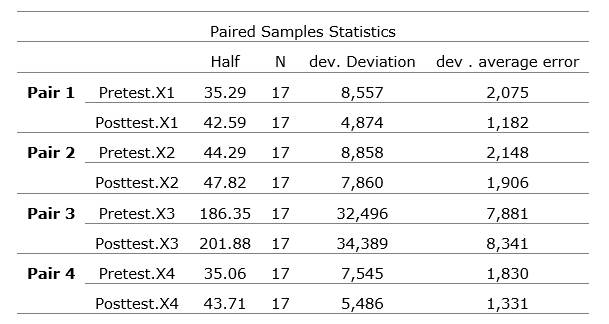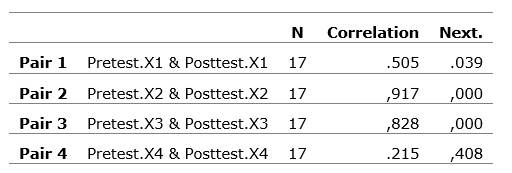Meu SciELO
Serviços Personalizados
Artigo
Indicadores
-
 Citado por SciELO
Citado por SciELO
Links relacionados
-
 Similares em
SciELO
Similares em
SciELO
Compartilhar
Podium. Revista de Ciencia y Tecnología en la Cultura Física
versão On-line ISSN 1996-2452
Rev Podium vol.17 no.2 Pinar del Río maio.-ago. 2022 Epub 13-Ago-2022
Original article
Incidence of functional training to potentiate strength in beginner swimmers of the Varadero club
1Universidad de las Fuerzas Armadas ESPE. Quito. Ecuador.
Functional training helps to enhance strength in certain muscle groups; in this way, the athlete improves body posture, gains muscle strength and endurance and, therefore, can increase indicators related to physical capacity and final performance. In this sense, the objective of the research was to apply a functional training program focused on the improvement of strength in beginner swimmers of the Varadero Club. The research is of descriptive-explanatory type of correlational order; a population of 17 swimmers (both genders; 14-16 years old) of the referred Club is diagnosed. A functional training adapted to the swimmer is applied on the basis of four physical indicators in two moments of applying said training. Significant differences are achieved in favor of the post- test in all the physical tests, both in the elbow flexion test (p=0.001) and in the abdominal test (p=0.001). In addition, the horizontal jump (p=0.005) and the vertical jump (p=0.001) are included. It is essential to potentiate the training of the physical capacity of strength in swimmers through a correct planning of functional training, given the strengthening of the muscles that intervene in the technical gesture. Four actions are recommended that influence the expansion of the study sample; emphasis is placed on the female gender; The results of the research are compared with other studies in other age ranges and a quasi-experimental type of research is carried out.
Key words: Functional Training; Strength; Swimming.
INTRODUCTION
Swimming is the movement and displacement in the aquatic environment that is carried out through the use of the lower and upper limbs. This skill is developed with the possibility of using any instrument or material to move forward (Laughlin, 2019). Swimming is usually practiced for many purposes, among which the following stand out: recreation, health, competitive sports, physical exercise or recreational sports, among other practices (Pérez, Murcia, 2018).
For Santana, 2020 "Swimming requires constant pulling power from the upper body, while maintaining a horizontal line to swim efficiently." (p.36). The arms and legs are the main propulsive systems and both are connected and extend from the middle. This means that the middle zone of the body serves as an anchor in swimming, while the back and legs only generate that power that the middle zone is capable of withstanding (Pérez, Murcia, 2018).
Among the sports training models to enhance swimming performance, there is the so-called functional training (Ozeker et al., 2020; Falk et al., 2019). This is based on performing exercises that adapt to the natural movements of the human body, which works the muscles and joints globally. In this sense, functional training includes daily movements or specific sports gestures; In this way, it improves body mobility, agility and balance, develops cardiovascular health, corrects posture, strengthens muscle mass and helps maintain weight (Resende-Neto, 2019).
For (Ríos, 2015) "Functional training means training with a purpose; seeks a positive effect on physical fitness related to health or performance depending on the sport practiced" (p.85). Said training focuses on the biomechanical function of human movement and this, in turn, is classified into four categories: locomotion, level changes, push and pull and changes of direction and these, in turn, are executed in movements of the daily life (Santana, 2020).
With functional training to improve swimming, what is needed is to work on determining capacities such as strength, which achieves better results according to some authors such as Ozeker et al., (2020). In addition, it is necessary to work all the muscle groups involved in the directly related activity which, in the case of this research, includes the muscles involved in freestyle or front crawl.
The muscles involved in the front crawl are: triceps brachii, deltoids, pectoralis minor, teres major, biceps brachii, latissimus dorsi, pectoralis major, pronators, supinators, trapezius, long and deep flexor of the fingers, palmaris major, palmaris minor, rectus abdominis, obliques and abdominals. What is intended is to plan a functional training in which these muscles are immersed. In this way, what is intended is to potentiate the strength in the beginner swimmers of the Varadero club; this can be verified in the phases of the front crawl technique, which are: start phase, push phase, final push phase and recovery phase (Aguilera, 2015), through a test applied before and after planning of functional training.
The physical capacity of strength is an essential direction for the performance of any human being, (Morales, González, 2015); here swimming is included as an Olympic modality, (Ravé et al., 2018; Lopes et al., 2021). From this it follows that its formal development should not be forgotten in the preparation of the athlete. In swimming, the types of strength used by the swimmer to move through the water are mainly conditioned by the environment in which the sports practice takes place.
Strength manifests itself in sports practice in three different forms of application: Maximum Strength (MF in Spanish), Explosive Strength (FE in Spanish) and Endurance to Strength (RF), (Morales, González, 2015). In the case of swimming, this will depend on whether the distance is short, deep and deep.
The importance of maximum strength and explosive strength is more relevant in short tests and as the distance of the test increases, endurance to strength becomes more important. Regarding the type of muscular metabolism referred to the specific tests for this study (distance and long distance), it will correspond to the endurance to aerobic strength (Fustillos et al., 2020) .
For Santana, (2020) Functional strength is classified into:
Absolute strength is the maximum amount of weight an athlete can lift.
Relative strength is the absolute strength of an athlete divided by body weight and is also a very popular form of strength within the sports arena. This type of strength is crucial for athletes who compete in sports divided into weight classes.
Functional strength is the amount of strength an athlete can use on the field, and is the most important strength to develop for non-weightlifting sports. What is sought with functional training is the development of functional strength.
Functional training as a methodology includes exercises and motor actions that help the subject to be functionally enhanced, so that training is useful when it comes to stimulating and preparing the systems for day-to-day activity. This improves sports performance in many ways. Functional training in some cases is treated as a rehabilitation mechanism for people who have suffered an injury; in this sense, tests have been applied to evaluate the level of these injuries with stratified scales (Mantilla, 2018; Aranda, 2018). These subjects need again to be able to recover lost mobility. On the other hand, the recovery process or phase is accelerated to continue with the performance of your daily tasks or sports practice.
In one way or another, this research has as its purpose: to apply a functional training program focused on improving the strength of the beginner swimmers of the Varadero Club.
MATERIALS AND METHODS
The research is descriptive-explanatory and correlational. A population of 17 swimmers from the Varadero Swimming Club of the city of Sangolqui-Ecuador, both sexes, is diagnosed. The study is carried out in the months of November to December 2021, until January 2022. These subjects are within a range between 14 and 16 years of age.
The main characteristics for the selection of the study subjects are: belonging to the Varadero Swimming Club, being within the established age ranges, attending training sessions according to the schedule of the club's coaches, complying with the tests proposed for the respective evaluation and informed consent.
During the evaluation process, together with professionals specialized in the sport of swimming, a strength pre-test was applied, focused on the analysis of the muscles involved in the front crawl style. Among the instruments, 2 tests of strength were applied, one for the upper body and one for the trunk (elbow flexion test (X1), abdominal test (X2), respectively) and two tests for the lower body (horizontal jump test (X3) A vertical jump test (X4)) was also applied together with the follow-up of the protocols for carrying out the evaluations.
Referential performance scales were applied according to authors specialized in this type of test already mentioned in the introduction to this work. The different performance assessment tests are clarified. On the other hand, a functional training plan was established, focused on developing the physical capacity of strength in swimmers, according to the results obtained in the four tests.
The functional training program has a hybrid orientation, which combines the best of functional training with the best of traditional training (strength, power and hypertrophy), during a 4-week microcycle. The study lasts from 30' to 60' per session; the execution of the movements with an effective technique is respected.
On the other hand, a periodization was used, working in a range of 10 to 12 series per muscle group. The technique was applied between 4 to 6 repetitions per series with adequate rest intervals for a respective recovery. Functional training was performed 3 days a week; DAY 1 (LEGS), DAY 2 (PUSH), DAY 3 (TRACTION), through the use of training materials such as kettlebells, slamball, mats, dumbbells, Olympic bars, pulleys, rubber bands and bands.
In this way, after the four weeks of functional training, the post-test was applied again with the aim of determining, through the established parameters, how the strength was in the swimmers at the end of the training planning.
The basic model of the functional program to enhance strength in the swimmers studied (Table 1).
Basic model of the functional program to enhance strength in the swimmers studied.
Considerations:
Volume (3-4 sets).
Exercise 1, range between 4 to 6 repetitions per muscle group.
Exercise 2, range from 10 to 20 repetitions.
Exercise 3, range from 10 to 20 repetitions.
The strength training pattern developed by Santana from his book Functional Training, was taken as a guide. Exercises and training programs to achieve maximum performance. For data tabulation, Microsoft Excel 2021 was used and SPSS v25 for statistical processing; the Shapiro-Wilk Test is specified, which demonstrated the existence of a normal distribution of the data, therefore, the t Test for related samples (≤0.05) is applied as a correlational statistician, expecting a reliability index of 95 %.
Although in the corresponding tables, an analysis by gender is performed, the correlations were established with all the subjects studied, since the female gender only included three subjects, being insufficient to establish the relevant correlations.
RESULTS AND DISCUSSION
Table 2 shows the results achieved in the tests implemented, as part of the beginning of the research or pretest. For a higher categorization, an additional classification by gender was performed (Table 2).
The results of table 2 as part of the pretest determined a mean in the first of the tests (X1) of 37 repetitions for males and 29 for females. A Medium level qualification was obtained in both genders in the elbow flexion test. On the other hand, in the X2 test, an average of 45 repetitions in the male gender and 41 repetitions in the female gender, for a rating of Good in both genders in the abdominal test.
For the case of the horizontal jump test (X3), the mean in the male gender was established at 191cm and in the female gender at 164cm, while for the vertical jump (X4) the mean in the male gender was established at 37cm. In the case of the female gender, it behaves in 28cm. In another sense, table 2 shows the results achieved as part of the post-test, after implementing the intervention proposal (Table 3).
The results achieved as part of the post-test are described as part of Table 3, where in the elbow flexion test an average of 43 movements or repetitions (+6) is established in the male gender. In the female gender, it takes 40 repetitions (+11), an increase in repetitions prevails in both genders, although the growth in the female gender was much higher. Student `s t-test showed the existence of significant differences in favor of the posttest (Table 4: p=0.001), indicating that the functional training implemented improved muscle strength in the upper limbs.
Of transcendental importance is the empowerment of the upper limbs in the swimmer, given the movement function in the water that the arms and hands have, (Lopes et al., 2021) for which, the greater the muscular strength in the arms, the greater the will be the swimmer's final performance, regardless of age range.
On the other hand, the sit-up test was superior as part of the post-test, which is dominated by a mean repetition for the male gender of 48rep (+3rep), and for the female gender of 47rep (+6rep). From here, significant differences are shown in favor of the post-test (p=0.001), given the presence of a higher mean according to the Student's t-test (Table 4). Thus, there is evidence of a greater enhancement of trunk strength in the female gender by more than 50 %.
This is indicative of a greater local muscle power in the trunk of the swimmers studied, after the intervention proposal was implemented. The importance of the abdominal trunk musculature for processes directly related to respiratory capacity is notable, as established in Karapolat, Daðlýoðlu, (2020).
In the case of muscle power in the lower limbs, the X3 Test determined a mean of 205cm for males (+14cm) and a mean of 189cm for females (+25cm). Significant differences prevail in favor of the post-test (p=0.005), while in Test X4 the mean in the male gender was established at 42cm (+5cm) and in the female gender 51cm (+23cm). On this last aspect, it is recommended to expand the sample in the female gender, which would allow increasing the reliability of the test.
Both in the Horizontal Jump Test and the Vertical Jump, significant differences were found in favor of the post-test (X3: p=0.005; X4: p=0.001), indicating that the proposed intervention with functional training significantly improved strength in lower limbs. This is a vitally important aspect of a swimmer's performance, since the legs are natural propellants when moving through the water (Keiner et al., 2021).
Detailed results with Student `s t-Test. (Table 4), (Table 5) and (Table 6).
The enhancement of strength in general and its variants such as maximum strength specifically, both in the upper and lower body, have a marked positive influence on the different techniques that make up the freestyle swim. This happens both at the beginning of the snatch block, as well as the turn and the general performance of the swimmer, as stated by Keineret al., (2021). This is an element that can be reinstrengthd by integrating other directly related physical abilities, such as motor coordination (Duchimasa et al., 2015; Seifert, Carmigniani, 2021).
On leg training days, traditional exercises such as lunges, squats, and deadlifts were performed. In addition, in the functional exercises, jump squats, burpees, jumps (vertical, long, alternate legs, skier) were worked on, among other exercises to potentiate the strength work in the leg muscles (quadriceps, hamstrings, calf muscles, adductors and buttocks).
In the same way, traditional exercises such as incline press, flat press, military press, lateral raises were trained in the pushing exercises. In the same way, functional exercises such as T-bends, dips, and wall throws were performed, since these exercises focus on working muscles such as the pectoral, triceps, and deltoid muscles. On the other hand, pull training trained exercises such as horizontal rowing, T-bar rowing, pullover rowing, bicep curls, along with functional exercises such as banded explosive rowing, pull-ups, and lower back rows. A focus is achieved on the muscular work of the back and biceps. In the same way, exercises were carried out in the training sessions to strengthen the middle area of the abdomen, focused on work on rotation and abdominal rigidity.
Within the analysis of the tests carried out on the population studied, it was possible to determine that the physical capacity of the strength was not adequate for the standard requirements of the swimmer. It is for this reason that a functional training plan focused on strength was carried out, which is considered a favorable test result in its second moment of application. This allows determining that strength work is important to achieve high sports performance.
All these exercises were performed using dumbbells, bars, rubber bands, kettlebells and other accessories that allowed the established planning to be fulfilled. However, as recommendations of the present research, the following should be considered:
CONCLUSIONS
In conclusion, the work of the physical capacity of the strength, allows having a better physical condition in swimmers as shown by the different research sources consulted. This favorably contributes to working on exercises that are adapted to the sport in a specific way in order to train the strengthening of the muscles involved in swimming.
As an alternative proposal, it is recommended that the coaches of the Varadero club carry out a plan that considers the work of strength in athletes to partially support functional training.
ACKNOWLEDGMENT
To the Varadero Club, for providing the facilities in the study and the predisposition shown by the subjects to carry out the research and to the Afidesa Research Group (Physical Activity, Sports and Health) of the University of the Armed Strengths Espe for advice and implementation of the intervention proposal.
REFERENCIAS BIBLIOGRÁFICAS
Aguilera, S. P., & Enero, Y. V. (2015). Análisis técnico del estilo de nado crol. Journal of Movement & Health, 16(1). https://dialnet.unirioja.es/servlet/articulo?codigo=6336471 [ Links ]
Aranda, E. (2018). Manual de pruebas para evaluación de la forma física. México: Universidad Autónoma de Yucatán. http://www.conader.com.gt/DOCS/PROYECTO%20GENERALIZACION/MANUAL-DE%20PRUEBAS%20FISICAS.pdf [ Links ]
Duchimasa, L. A., Calero, S., & Chávez, E. (2015). Ejercicios coordinativos para las técnicas alternas en natación de deportistas de 11 a 12 años de edad. Estudio en el Club Tomebamba de la provincia de Azuay, Ecuador. Lecturas: Educación Física y Deportes, 20(212), 1-14. 07/10/2021. https://www.efdeportes.com/efd212/ejercicios-para-las-tecnicas-alternas-en-natacion.htm [ Links ]
Falk Neto, J. H., & Kennedy, M. D. (2019). The multimodal nature of high-intensity functional training: potential applications to improve sport performance. Sports, 7(2), 33. https://doi.org/10.3390/sports7020033 [ Links ]
Fustillos, W. D., Portilla, B. A., & Jaramillo, M. L. (2020). Potenciación de la resistencia-fuerza en triatletas senior, disciplina natación. Lecturas: Educación Física y Deportes , 25(266), 124-133. https://doi.org/10.46642/efd.v25i266.2356 [ Links ]
Karapolat, S., & Daðlýoðlu, O. (2020). Effectofcore training program on respiratory function and inspiratory muscle strength in swimmers. Europe an Journa lof Physica lEducation and Sport Science, 6(9), 128-137. https://doi.org/10.46827/ejpe.v6i9.3499 [ Links ]
Keiner, M., Wirth, K., Fuhrmann, S., Kunz, M., Hartmann, H., & Haff, G. G. (2021). The influence of upper-and lower-body maximum streng thonswim block start, turn, and overallswim performance in sprint swimming. Journal of strength and condition ingresearch, 35(10), 2839-2845. https://doi.org/10.1519/JSC.0000000000003229 [ Links ]
Laughlin, T. (2019). Natación para todos: Una guía para nadar mejor de lo que nunca había imaginado. Barcelona: Paidotribo. https://paidotribo.com/products/natacion-para-todos-una-guia-para-nadar-mejor-de-lo-que-nunca-habia-imaginado [ Links ]
Lopes, T. J., Neiva, H. P., Gonçalves, C. A., Nunes, C., & Marinho, D. A. (2021). The effects of dry-lands trength training on competitive esprinterswimmers. Journal of Exercise Science& Fitness, 19(1), 32-39. https://doi.org/10.1016/j.jesf.2020.06.005 [ Links ]
Mantilla, J. I. (2018). Fisioterapia y su rol en el alto rendimiento: una revisión sistemática de la literatura. Revista Iberoamericana de Ciencias de la Actividad física y el deporte, 7(1), 1-12. https://doi.org/10.24310/riccafd.2018.v7i1.4853 [ Links ]
Morales, S. C., & González, S. A. (2015). Preparación física y deportiva. Quito, Ecuador: Editorial de la Universidad de las Fuerzas Armadas ESPE. 19/01/2021. http://repositorio.espe.edu.ec/bitstream/21000/10201/1/Preparacion%20fisica%20y%20deportivaf.pdf [ Links ]
Ozeker, K. Y., Bilge, M., & Yildirim, D. S. (2020). The effect of dry-land training on functional strength and swimming performance of 10-12 years olds wimmers. Progress in Nutrition, 22(2), 1-10. https://doi.org/10.23751/pn.v22i2-S.10615 [ Links ]
Pérez, A. A., & Murcia, J. A. (2018). Natación en la escuela: hacia una alfabetización acuática. Revista de Investigación en Actividades Acuáticas, 2(3), 54-67. https://doi.org/10.21134/riaa.v2i3.405 [ Links ]
Ravé, J. M., Legaz-Arrese, A., González-Mohíno, F., Yustres, I., Barragán, R., de Asís Fernández, F., & Arroyo-Toledo, J. J. (2018). The effects of two different resisted swim training load protocols on swimming strength and performance. Journal of human kinetics, 64(1), 195-204. https://doi.org/ 10.1515/hukin-2017-0194 [ Links ]
Resende-Neto, A. G. (2019). Effects of functional training on body composition, physical fitness, cognitive status and cardiovascular health in the older people. Int J Geriatr Gerontol, 3(117), 2577-0748. https://doi.org/10.29011/2577-0748.100017 [ Links ]
Ríos, I. D. (2015). Entrenamiento funcional del core: eje del entrenamiento inteligente. Revista Facultad de Ciencias de la Salud UDES, 2(1), 47-55. https://doi.org/10.20320/rfcsudes.v2i1.247 [ Links ]
Santana, J. C. (2020). Entrenamiento Funcional santana. Ejercicios y programas de entrenamiento para conseguir el máximo rendimiento. Madrid: Tutor. https://www.casadellibro.com/libro-entrenamiento-funcional-ejercicios-y-programas-de-entrenamiento-para-conseguir-el-maximo-rendimiento/9788416676187/6467822 [ Links ]
Seifert, L., & Carmigniani, R. (2021). Coordination and stroking parameters in thef ours wimming techniques: a narrative review. Sports Biome chanics, 2021, 1-17. https://doi.org/10.1080/14763141.2021.1959945 [ Links ]
Received: February 06, 2022; Accepted: May 09, 2022











 texto em
texto em 








